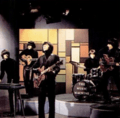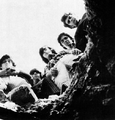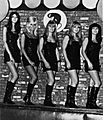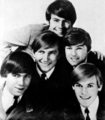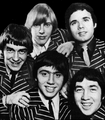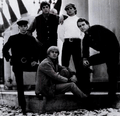Garage rock facts for kids
Quick facts for kids Garage rock |
|
|---|---|
| Stylistic origins |
|
| Cultural origins | Late 1950s, United States and Canada |
| Typical instruments | |
| Derivative forms |
|
| Fusion genres | |
| Garage punk | |
| Regional scenes | |
|
|
Garage rock is a lively and powerful style of rock and roll music. It became popular in the mid-1960s. This music was especially big in the United States and Canada. At first, people didn't call it a specific type of music. Later, in the early 1970s, music writers started to notice its unique sound. This helped it become known as its own musical genre.
It got the name "garage rock" because many bands were young and just starting out. They were often high school or college students. Sometimes, they practiced their music in their families' garages. Some bands were older and already professional. These groups are often called "garage bands."
Contents
What Is Garage Rock Music Like?
The garage rock style often had very simple lyrics. Bands sometimes used a special device called a fuzzbox. This device made their guitars sound distorted or fuzzy. This unique sound became a key part of the music.
Early Influences on Garage Rock
Surf rock music was an early influence on garage rock. Surf rock often featured electric guitars and a strong beat. Later, bands like The Beatles became very popular. Other beat groups from the British Invasion also inspired many young musicians.
When Did Garage Rock Become Popular?
From 1963 to 1968, many new bands formed in the United States and other countries. These bands wanted to play music like their favorite British groups. Some garage bands had hit songs that were popular in their local areas. A few even had songs that became national hits across the country.
How Did Garage Rock Change Over Time?
As psychedelia grew popular, some garage bands started to change their sound. They added strange and unusual elements to their music. After 1968, rock music became more complex. Because of this, garage rock songs became less popular.
How Is Garage Rock Related to Punk Rock?
In the early 1970s, some music critics began to call this style "punk rock." This makes garage rock the first type of music to use that name. To tell it apart from the later punk rock movement of the 1970s, it's sometimes called "garage punk." Other names include "protopunk" or "'60s punk."
Garage Rock's Lasting Influence
The garage rock style has been brought back several times in recent years. It still inspires many modern bands today. These bands like the "back to basics" approach of garage rock. They also enjoy its "do it yourself" attitude towards making music.
Images for kids
-
Link Wray, pictured in 1993, helped create the use of guitar power chords and distortion as early as 1958 with his song, "Rumble." He influenced early garage rock.
-
The Pleasure Seekers in 1966 (Suzi Quatro far right)
-
Paul Revere & the Raiders in 1967
-
Them, featuring Van Morrison (center), in 1965
-
The Easybeats in 1966
-
The Monks added avant-garde (experimental) elements to garage rock.
-
Iggy Pop was a member of the Stooges. They are seen as one of the most important proto-punk bands.
-
The Ramones (pictured in 1977) were influenced by garage rock. They led the mid-1970s punk movement in New York.
See also
 In Spanish: Garage rock para niños
In Spanish: Garage rock para niños



